See Page 1 |
2 |
3 |
4 | of the April 2024 homepage archives. Friday the 12th
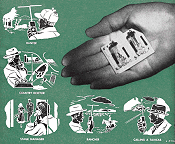 This article is a good indicator of how
prevalent cigarettes were back in 1948 when it appeared in Popular Science
magazine. Transmitter, receiver, and hearing air amplifiers were referenced to be
"about the size of a pack of cigarettes." The peanut vacuum tubes used within are
said to be "smaller than a half-smoked cigarette." Those of us who lived back in
the days when smoke-filled restaurants, buses, grocery stores, and houses was the
norm easily compare the sizes to such a familiar entity. We even know what it means
to be "smaller than a bread box." Nowadays, references to the size of electronic
components would be to something like a grain of sand, which is a form of irony
since that's what the chip is made from (essentially). The article's title, "The
Radio That Was Shot from a Gun," derives from the miniaturization technology
developed for anti-aircraft shell proximity fuses... This article is a good indicator of how
prevalent cigarettes were back in 1948 when it appeared in Popular Science
magazine. Transmitter, receiver, and hearing air amplifiers were referenced to be
"about the size of a pack of cigarettes." The peanut vacuum tubes used within are
said to be "smaller than a half-smoked cigarette." Those of us who lived back in
the days when smoke-filled restaurants, buses, grocery stores, and houses was the
norm easily compare the sizes to such a familiar entity. We even know what it means
to be "smaller than a bread box." Nowadays, references to the size of electronic
components would be to something like a grain of sand, which is a form of irony
since that's what the chip is made from (essentially). The article's title, "The
Radio That Was Shot from a Gun," derives from the miniaturization technology
developed for anti-aircraft shell proximity fuses...
 I wonder if this this is an actually representative
of the SmallSat mentioned in the article. It looks like someone Photoshopped a set
of PV panels on a standard subsystem module package. "Terran Orbital Corporation
has made a significant move into the geosynchronous orbit (GEO) small satellite
market with its unveiling of the
SmallSat GEO solution, designed for satellites weighing over 500kg. This cutting-edge
solution will be showcased at the upcoming SATELLITE 2024 trade show from March
18-21 at the Walter E. Washington Convention Center, Washington D.C., featuring
an immersive augmented reality experience. The SmallSat GEO solution is specifically
crafted for the communications sector, capable of operating in geosynchronous orbit
to deliver unprecedented power and performance, a demand that has surged in the
GEO sector's gradual shift towards smaller satellites. Leveraging a state-of-the-art
94,000 sq. ft. manufacturing facility equipped with advanced automation in both
construction and testing, along with the experience gained from three prior GEO
missions..." I wonder if this this is an actually representative
of the SmallSat mentioned in the article. It looks like someone Photoshopped a set
of PV panels on a standard subsystem module package. "Terran Orbital Corporation
has made a significant move into the geosynchronous orbit (GEO) small satellite
market with its unveiling of the
SmallSat GEO solution, designed for satellites weighing over 500kg. This cutting-edge
solution will be showcased at the upcoming SATELLITE 2024 trade show from March
18-21 at the Walter E. Washington Convention Center, Washington D.C., featuring
an immersive augmented reality experience. The SmallSat GEO solution is specifically
crafted for the communications sector, capable of operating in geosynchronous orbit
to deliver unprecedented power and performance, a demand that has surged in the
GEO sector's gradual shift towards smaller satellites. Leveraging a state-of-the-art
94,000 sq. ft. manufacturing facility equipped with advanced automation in both
construction and testing, along with the experience gained from three prior GEO
missions..."
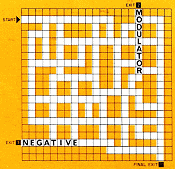 Robert Radford's (not to be confused with
Robert Redford) "Electromaze"
is a unique - and weird - sort of word puzzle format which first appeared in the
April 1966 issue of Popular Electronics magazine. Some people were confused
about the strategy, believing that all the white spaces needed to be filled in.
They do not. Just because a letter might have an empty square adjacent to it does
not imply that another letter must fill it. You will probably want to print out
the maze grid and find an old guy who should still have a pencil stowed away somewhere
you can borrow to use for filling in the boxes... Robert Radford's (not to be confused with
Robert Redford) "Electromaze"
is a unique - and weird - sort of word puzzle format which first appeared in the
April 1966 issue of Popular Electronics magazine. Some people were confused
about the strategy, believing that all the white spaces needed to be filled in.
They do not. Just because a letter might have an empty square adjacent to it does
not imply that another letter must fill it. You will probably want to print out
the maze grid and find an old guy who should still have a pencil stowed away somewhere
you can borrow to use for filling in the boxes...
 Werbel Microwave, located in Whippany, New
Jersey, is a producer of high quality passive power RF and microwave components
across a worldwide customer base. A partnership has recently been established with
Canada's
Global Electromarketing, a sales representative agency which focuses on market
research, competitive analysis, and brand positioning. Werbel's founder and president
Ernest Werbel says, "We are looking forward to growth and success together." Werbel
Microwave designs and manufactures RF directional and bidirectional couplers (6 dB
to 50 dB) and RF power dividers / combiners (2− to 16−way) with select models
operating up to 26.5 GHz and 100 W of CW power (3 kW peak). All are
RoHS and REACH compliant and are designed and manufactured in our Whippany, NJ,
location. Custom products and private label service available. Werbel Microwave, located in Whippany, New
Jersey, is a producer of high quality passive power RF and microwave components
across a worldwide customer base. A partnership has recently been established with
Canada's
Global Electromarketing, a sales representative agency which focuses on market
research, competitive analysis, and brand positioning. Werbel's founder and president
Ernest Werbel says, "We are looking forward to growth and success together." Werbel
Microwave designs and manufactures RF directional and bidirectional couplers (6 dB
to 50 dB) and RF power dividers / combiners (2− to 16−way) with select models
operating up to 26.5 GHz and 100 W of CW power (3 kW peak). All are
RoHS and REACH compliant and are designed and manufactured in our Whippany, NJ,
location. Custom products and private label service available.
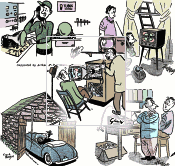 The January 1951 issue of Radio-Electronics
magazine had a big collection of
electronics-themed comics - five of them. All of them are pretty good, and you
don't need to have been there during the early TV era to appreciate the humor. The
comic from page 127 is a good first step in troubleshooting for today, and is usually
at the top of the problem solving section of consumer gear throughout the electronic
age. The page 126 comic is an oft-used gag for garage-related funnies. Although
not directly related, it reminds me of how early wireless garage door openers had
their antennas stretched underneath of the car, as mentioned in other articles,
including "The New Radio Garage Door Opener." I colorized them all... The January 1951 issue of Radio-Electronics
magazine had a big collection of
electronics-themed comics - five of them. All of them are pretty good, and you
don't need to have been there during the early TV era to appreciate the humor. The
comic from page 127 is a good first step in troubleshooting for today, and is usually
at the top of the problem solving section of consumer gear throughout the electronic
age. The page 126 comic is an oft-used gag for garage-related funnies. Although
not directly related, it reminds me of how early wireless garage door openers had
their antennas stretched underneath of the car, as mentioned in other articles,
including "The New Radio Garage Door Opener." I colorized them all...
 With more than 1000
custom-built symbols, this has got to be the most comprehensive set of
Visio Symbols
available for RF, analog, and digital system and schematic drawings! Every object
has been built to fit proportionally on the provided A-, B- and C-size drawing page
templates (or can use your own). Symbols are provided for equipment racks and test
equipment, system block diagrams, conceptual drawings, and schematics. Unlike previous
versions, these are NOT Stencils, but instead are all contained on tabbed pages
within a single Visio document. That puts everything in front of you in its full
glory. Just copy and paste what you need on your drawing... With more than 1000
custom-built symbols, this has got to be the most comprehensive set of
Visio Symbols
available for RF, analog, and digital system and schematic drawings! Every object
has been built to fit proportionally on the provided A-, B- and C-size drawing page
templates (or can use your own). Symbols are provided for equipment racks and test
equipment, system block diagrams, conceptual drawings, and schematics. Unlike previous
versions, these are NOT Stencils, but instead are all contained on tabbed pages
within a single Visio document. That puts everything in front of you in its full
glory. Just copy and paste what you need on your drawing...
 TotalTemp Technologies has more than 40
years of combined experience providing thermal platforms.
Thermal Platforms are
available to provide temperatures between −100°C and +200°C for cryogenic cooling,
recirculating & circulating coolers, temperature chambers and temperature controllers,
thermal range safety controllers, space simulation chambers, hybrid benchtop chambers,
custom systems and platforms. Manual and automated configurations for laboratory
and production environments. Please contact TotalTemp Technologies today to learn
how they can help your project. TotalTemp Technologies has more than 40
years of combined experience providing thermal platforms.
Thermal Platforms are
available to provide temperatures between −100°C and +200°C for cryogenic cooling,
recirculating & circulating coolers, temperature chambers and temperature controllers,
thermal range safety controllers, space simulation chambers, hybrid benchtop chambers,
custom systems and platforms. Manual and automated configurations for laboratory
and production environments. Please contact TotalTemp Technologies today to learn
how they can help your project.
Thursday the 11th
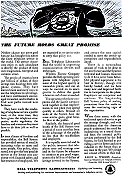 If you remember watching movies and television
shows up through the 1970s or so, you have probably seen scenes (see what I did
there?) where someone struggled desperately to place and keep connected telephone
calls to, from, or within foreign countries (outside the U.S., that is). Our
Bell Telephone Company was well known and respected for the widespread, reliable,
and quality network it built out across the land. A continual effort to improve
the system while containing costs to make telephony affordable to most people is
what did the job. Beginning with manually (or more accurately, womanually) operated
switchboards, then graduating to automated electromechanical circuit switching centers,
it eventually evolved to the computer controlled and optimized solid state networking
circuits of today. Unlike the multitude of telecommunications companies today, Bell
really had no competition, so government oversight combined with the company's desire
to invoke good will amongst its customers helped keep things in check. Self-promotions
like this full-page 1949 Popular Science magazine appearance were common. If you remember watching movies and television
shows up through the 1970s or so, you have probably seen scenes (see what I did
there?) where someone struggled desperately to place and keep connected telephone
calls to, from, or within foreign countries (outside the U.S., that is). Our
Bell Telephone Company was well known and respected for the widespread, reliable,
and quality network it built out across the land. A continual effort to improve
the system while containing costs to make telephony affordable to most people is
what did the job. Beginning with manually (or more accurately, womanually) operated
switchboards, then graduating to automated electromechanical circuit switching centers,
it eventually evolved to the computer controlled and optimized solid state networking
circuits of today. Unlike the multitude of telecommunications companies today, Bell
really had no competition, so government oversight combined with the company's desire
to invoke good will amongst its customers helped keep things in check. Self-promotions
like this full-page 1949 Popular Science magazine appearance were common.
 An
article on the TechExplore website entitled, "Why
won't some people use a smartphone? And is that difficult?," states, "In a world
where more and more services and social interaction are based on mobile apps, a
smartphone has become close to a necessity. Despite this, some people avoid smartphones
and instead use a dumbphone - a traditional mobile phone or a reduced-feature designer
phone." One contributor remarked: "We found that in many societies, all sorts of
tricks had to be invented to make life without a smartphone work." Um, does the
university prof not realize that life "worked" just fine for the preceding many
millennia without a smartphone? Evidently now if you don't feel the need to be "connected"
24/7, you're considered a weirdo. Well, count me in that group. I rarely carry a
phone - dumb or smart. I read from and write (even cursive) on paper. I look up
definitions and spellings in a printed Webster dictionary. My landline phone sits
on the desk and has a handset on a curly cord. I eat meals and do household tasks
without checking a phone ...been managing to eek out a survival that way for 65
years now. Other than by tracking purchases on credit cards around town, nobody
has a record of my whereabouts or schedule. I pity the phone slaves. An
article on the TechExplore website entitled, "Why
won't some people use a smartphone? And is that difficult?," states, "In a world
where more and more services and social interaction are based on mobile apps, a
smartphone has become close to a necessity. Despite this, some people avoid smartphones
and instead use a dumbphone - a traditional mobile phone or a reduced-feature designer
phone." One contributor remarked: "We found that in many societies, all sorts of
tricks had to be invented to make life without a smartphone work." Um, does the
university prof not realize that life "worked" just fine for the preceding many
millennia without a smartphone? Evidently now if you don't feel the need to be "connected"
24/7, you're considered a weirdo. Well, count me in that group. I rarely carry a
phone - dumb or smart. I read from and write (even cursive) on paper. I look up
definitions and spellings in a printed Webster dictionary. My landline phone sits
on the desk and has a handset on a curly cord. I eat meals and do household tasks
without checking a phone ...been managing to eek out a survival that way for 65
years now. Other than by tracking purchases on credit cards around town, nobody
has a record of my whereabouts or schedule. I pity the phone slaves.
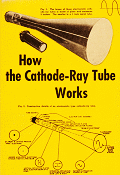 Even with the domination of LED, plasma,
and LCD displays, there are still
cathode ray tubes (CRTs) on the job. Hobbyists workbenches are filled with them
for sure, but design and manufacturing facilities still have huge inventories of
test equipment with CRTs, and a lot of computer equipment on the production line
with CRTs sitting in racks. LED, LCD, and plasma displays all have their own claims
to genius on the part of their designers, but cathode ray tube designers - and the
designers of the driver circuits - deserve special recognition. Consider the physics
and materials involved: glass, phosphor, magnetics, thermonics, electrostatics and
electrodynamics, relativity (electrons traveling at relativistic speeds gain mass,
requiring stronger deflection fields). This article from the February 1955 edition
of Popular Electronics provides a look into the CRT from a layman's perspective... Even with the domination of LED, plasma,
and LCD displays, there are still
cathode ray tubes (CRTs) on the job. Hobbyists workbenches are filled with them
for sure, but design and manufacturing facilities still have huge inventories of
test equipment with CRTs, and a lot of computer equipment on the production line
with CRTs sitting in racks. LED, LCD, and plasma displays all have their own claims
to genius on the part of their designers, but cathode ray tube designers - and the
designers of the driver circuits - deserve special recognition. Consider the physics
and materials involved: glass, phosphor, magnetics, thermonics, electrostatics and
electrodynamics, relativity (electrons traveling at relativistic speeds gain mass,
requiring stronger deflection fields). This article from the February 1955 edition
of Popular Electronics provides a look into the CRT from a layman's perspective...
 Exodus Advanced Communications, is a multinational
RF communication equipment and engineering service company serving both commercial
and government entities and their affiliates worldwide. We are pleased to present
the new Exodus
AMP2070A solid state high power amplifier, ideal for broadband EMI−Lab, Communication
and EW applications. Class A/AB linear design for all modulations & industry
standards. Covers 1.0 to 6.0 GHz, producing 150 W minimum Psat, 100 W
minimum P1dB, and 52 dB minimum gain, with 20 dB gain adjustment. Excellent
flatness, optional monitoring parameters for Forward/Reflected power, VSWR, voltage,
current & temperature sensing for superb reliability and ruggedness. Integrated
in our compact 3U chassis weighing approximately 25 kg... Exodus Advanced Communications, is a multinational
RF communication equipment and engineering service company serving both commercial
and government entities and their affiliates worldwide. We are pleased to present
the new Exodus
AMP2070A solid state high power amplifier, ideal for broadband EMI−Lab, Communication
and EW applications. Class A/AB linear design for all modulations & industry
standards. Covers 1.0 to 6.0 GHz, producing 150 W minimum Psat, 100 W
minimum P1dB, and 52 dB minimum gain, with 20 dB gain adjustment. Excellent
flatness, optional monitoring parameters for Forward/Reflected power, VSWR, voltage,
current & temperature sensing for superb reliability and ruggedness. Integrated
in our compact 3U chassis weighing approximately 25 kg...
 Short wave radio was a boon to both professional
and amateur radio operators because of its ability to be received over longer distances
using significantly lower transmitter power. In 1947 when this article appeared
in Radio-Craft magazine, the problem was (and still is) that short wave
bands typically suffer from
atmospheric ionization effects that vary depending on time of day, local weather,
solar activity, pollution, and other phenomena. Long wave's advantage was that although
it required higher power and longer antennas, it was (and is) extremely reliable.
For other than the most critical applications, idiosyncrasies of short wave communications
were accepted as the price of more convenient and lower cost operation. Widespread
adoption of short wave communications brought extensive studies and characterization
of atmospheric influences in particular frequency bands. Discovery of distinct "F"
layers (regions) in the ionosphere and their effects on radio transmission has allowed
radio operations to predict and accommodate the affected propagation paths. What
does the "F" in F-Layer mean? According to my sources the "F" refers not to frequency,
but to "free" electrons in the ionosphere... Short wave radio was a boon to both professional
and amateur radio operators because of its ability to be received over longer distances
using significantly lower transmitter power. In 1947 when this article appeared
in Radio-Craft magazine, the problem was (and still is) that short wave
bands typically suffer from
atmospheric ionization effects that vary depending on time of day, local weather,
solar activity, pollution, and other phenomena. Long wave's advantage was that although
it required higher power and longer antennas, it was (and is) extremely reliable.
For other than the most critical applications, idiosyncrasies of short wave communications
were accepted as the price of more convenient and lower cost operation. Widespread
adoption of short wave communications brought extensive studies and characterization
of atmospheric influences in particular frequency bands. Discovery of distinct "F"
layers (regions) in the ionosphere and their effects on radio transmission has allowed
radio operations to predict and accommodate the affected propagation paths. What
does the "F" in F-Layer mean? According to my sources the "F" refers not to frequency,
but to "free" electrons in the ionosphere...
 Banner Ads are rotated in all locations
on the page! RF Cafe typically receives 8,000-15,000 visits each
weekday. RF Cafe
is a favorite of engineers, technicians, hobbyists, and students all over the world.
With more than 17,000 pages in the Google search index, RF Cafe returns in
favorable positions on many types of key searches, both for text and images.
Your Banner Ads are displayed on average 280,000 times per year! New content
is added on a daily basis, which keeps the major search engines interested enough
to spider it multiple times each day. Items added on the homepage often can be found
in a Google search within a few hours of being posted. If you need your company
news to be seen, RF Cafe is the place to be... Banner Ads are rotated in all locations
on the page! RF Cafe typically receives 8,000-15,000 visits each
weekday. RF Cafe
is a favorite of engineers, technicians, hobbyists, and students all over the world.
With more than 17,000 pages in the Google search index, RF Cafe returns in
favorable positions on many types of key searches, both for text and images.
Your Banner Ads are displayed on average 280,000 times per year! New content
is added on a daily basis, which keeps the major search engines interested enough
to spider it multiple times each day. Items added on the homepage often can be found
in a Google search within a few hours of being posted. If you need your company
news to be seen, RF Cafe is the place to be...
Wednesday the 10th
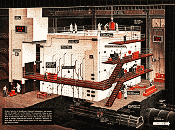 A Wikipedia on the history of nuclear power
shows a photo of the first light bulbs ever lit by electricity generated by nuclear
power, at EBR-1 at Argonne National Laboratory-West, December 20, 1951. That was
two years after this "U.S.
Lights New Atomic Pile for Peace" article in Popular Science magazine,
which discusses progress at the Brookhaven National Laboratory, located in New York
state. It opened in 1947. Much public excitement - and fear - was fomented over
the use of nuclear energy, which had just four years earlier been used to bring
an end to World War II through its awesome level of concentrated destructiveness,
for peaceful uses like generating electrical power and for medicine. During the
postwar era, many such articles, which some considered propaganda, were published,
television shows aired, and movies produced in attempts to turn the public into
pro- or anti- nuclear power activists. The "anti's" have done a pretty good scaring
everyone to the point where rather than benefitting from the very "green" aspects
of nuclear power (which would have been continually improving in technology), they
instead are accepting monstrous installations of solar arrays, wind turbine farms,
and other impractical technologies. Their cost to society, economies, and the environment
are rarely reported honestly. A Wikipedia on the history of nuclear power
shows a photo of the first light bulbs ever lit by electricity generated by nuclear
power, at EBR-1 at Argonne National Laboratory-West, December 20, 1951. That was
two years after this "U.S.
Lights New Atomic Pile for Peace" article in Popular Science magazine,
which discusses progress at the Brookhaven National Laboratory, located in New York
state. It opened in 1947. Much public excitement - and fear - was fomented over
the use of nuclear energy, which had just four years earlier been used to bring
an end to World War II through its awesome level of concentrated destructiveness,
for peaceful uses like generating electrical power and for medicine. During the
postwar era, many such articles, which some considered propaganda, were published,
television shows aired, and movies produced in attempts to turn the public into
pro- or anti- nuclear power activists. The "anti's" have done a pretty good scaring
everyone to the point where rather than benefitting from the very "green" aspects
of nuclear power (which would have been continually improving in technology), they
instead are accepting monstrous installations of solar arrays, wind turbine farms,
and other impractical technologies. Their cost to society, economies, and the environment
are rarely reported honestly.
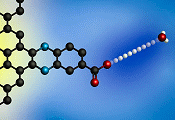 "New
insights into how
proton-coupled electron transfers occur at an electrode could help researchers
design more efficient fuel cells and electrolyzers. A key chemical reaction - in
which the movement of protons between the surface of an electrode and an electrolyte
drives an electric current - is a critical step in many energy technologies, including
fuel cells and the electrolyzers used to produce hydrogen gas. For the first time,
MIT chemists have mapped out in detail how these proton-coupled electron transfers
happen at an electrode surface. Their results could help researchers design more
efficient fuel cells, batteries, or other energy technologies. 'Our advance in this
paper was studying and understanding the nature of how these electrons and protons
couple at a surface site, which is relevant for catalytic reactions that are important
in the context of energy conversion devices or catalytic reactions..." "New
insights into how
proton-coupled electron transfers occur at an electrode could help researchers
design more efficient fuel cells and electrolyzers. A key chemical reaction - in
which the movement of protons between the surface of an electrode and an electrolyte
drives an electric current - is a critical step in many energy technologies, including
fuel cells and the electrolyzers used to produce hydrogen gas. For the first time,
MIT chemists have mapped out in detail how these proton-coupled electron transfers
happen at an electrode surface. Their results could help researchers design more
efficient fuel cells, batteries, or other energy technologies. 'Our advance in this
paper was studying and understanding the nature of how these electrons and protons
couple at a surface site, which is relevant for catalytic reactions that are important
in the context of energy conversion devices or catalytic reactions..."
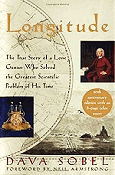 Knowing that I am an avid consumer of literature
pertaining to time and astronomy, Melanie picked up a book at the library for me
entitled,
Longitude: The True Story of a Lone Genius Who Solved the Greatest Scientific
Problem of His Time, by Dava Sobel. When Christopher Columbus discovered
America, his intended target was, if you recall, the Indies. His original charter
was to find a direct westerly pathway from the Atlantic coast of Europe to the immensely
profitable trade production region of the Indies as an alternative to to sailing
around the treacherous Cape of Good Hope at the southern tip of Africa. How could
such an experienced navigator have missed his mark by so far, you might reasonably
ask? Didn't Columbus know how to use a sextant, or at least have a navigator who
could? The answer to the second question is, "no." The answer to the first question
is complicated. Recall your elementary school poem titled In 1942, which began "In
fourteen hundred ninety-two, Columbus sailed the ocean blue." John Hadley's and
Thomas Godfrey's sextant - originally called an octant - was not invented and refined
until the middle of the 18th century. The answer to the first question is that prior
to the advent of the sextant and accurate sea-going clocks, determining latitude
was easy, but determining longitude was mostly guesswork and dead reckoning... Knowing that I am an avid consumer of literature
pertaining to time and astronomy, Melanie picked up a book at the library for me
entitled,
Longitude: The True Story of a Lone Genius Who Solved the Greatest Scientific
Problem of His Time, by Dava Sobel. When Christopher Columbus discovered
America, his intended target was, if you recall, the Indies. His original charter
was to find a direct westerly pathway from the Atlantic coast of Europe to the immensely
profitable trade production region of the Indies as an alternative to to sailing
around the treacherous Cape of Good Hope at the southern tip of Africa. How could
such an experienced navigator have missed his mark by so far, you might reasonably
ask? Didn't Columbus know how to use a sextant, or at least have a navigator who
could? The answer to the second question is, "no." The answer to the first question
is complicated. Recall your elementary school poem titled In 1942, which began "In
fourteen hundred ninety-two, Columbus sailed the ocean blue." John Hadley's and
Thomas Godfrey's sextant - originally called an octant - was not invented and refined
until the middle of the 18th century. The answer to the first question is that prior
to the advent of the sextant and accurate sea-going clocks, determining latitude
was easy, but determining longitude was mostly guesswork and dead reckoning...
 Members of Congress - both the House and
the Senate - are not necessarily there because they are exceptionally smart and/or
wise. An argument can be made that they are there because their constituents are
exceptionally stupid and/or unwise. In an address to students at the Booker T. Washington
High School in Houston, Texas, Rep. Sheila Jackson Lee stated, among other
dumb things, "the full moon is a complete, rounded circle,
which is made up mostly of
gasses." She previously claimed the Constitution is more than 400 years
old, and that astronauts planted an American flag on Mars (look it up). BTW, she
was a member of the House Science, Space and Technology Committee. Rep. Hank
Johnson worried back in 2011 that the
island of Guam might tip over
under the weight of excessive military gear. Many other examples of idiocy amongst
our "leaders" can be found. Members of Congress - both the House and
the Senate - are not necessarily there because they are exceptionally smart and/or
wise. An argument can be made that they are there because their constituents are
exceptionally stupid and/or unwise. In an address to students at the Booker T. Washington
High School in Houston, Texas, Rep. Sheila Jackson Lee stated, among other
dumb things, "the full moon is a complete, rounded circle,
which is made up mostly of
gasses." She previously claimed the Constitution is more than 400 years
old, and that astronauts planted an American flag on Mars (look it up). BTW, she
was a member of the House Science, Space and Technology Committee. Rep. Hank
Johnson worried back in 2011 that the
island of Guam might tip over
under the weight of excessive military gear. Many other examples of idiocy amongst
our "leaders" can be found.
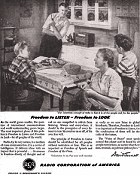 This RCA (Radio Corporation of America)
advertisement from a 1948 issue of Radio−Craft magazine packed a lot of
meaning to American citizens who had recently experienced the trials, tribulations,
and ultimately victories of World War II. Company president David Sarnoff,
a well-known electronic communications industry titan before the war, served under
a special commission as a Brigadier General in the U.S. Army during WWII to
oversee radio communications. He was very familiar with the tragedy of Communism
and Socialism, having experienced its ruinous philosophy. Hitler and his minions
forbade citizens, under threat of imprisonment or worse, from listening to radios
lest they learn of the war's progress or of the freedoms experienced in other parts
of the world. Propaganda via radio was a daunting weapon for and against all engaged
nations, and even some Allied governments outlawed both transmitters and receivers
for the duration. This advertisement represents the appreciation Mr. Sarnoff
and his countrymen had for the simple ability to listen to radio broadcasts without
fear of retribution. The scenario depicted in the picture is similar to the famous
"Four Freedoms" paintings done by American artist Norman Rockwell in 1943. RCA added
"Freedom
to Listen" to Rockwell's list for a total of Five Freedoms... This RCA (Radio Corporation of America)
advertisement from a 1948 issue of Radio−Craft magazine packed a lot of
meaning to American citizens who had recently experienced the trials, tribulations,
and ultimately victories of World War II. Company president David Sarnoff,
a well-known electronic communications industry titan before the war, served under
a special commission as a Brigadier General in the U.S. Army during WWII to
oversee radio communications. He was very familiar with the tragedy of Communism
and Socialism, having experienced its ruinous philosophy. Hitler and his minions
forbade citizens, under threat of imprisonment or worse, from listening to radios
lest they learn of the war's progress or of the freedoms experienced in other parts
of the world. Propaganda via radio was a daunting weapon for and against all engaged
nations, and even some Allied governments outlawed both transmitters and receivers
for the duration. This advertisement represents the appreciation Mr. Sarnoff
and his countrymen had for the simple ability to listen to radio broadcasts without
fear of retribution. The scenario depicted in the picture is similar to the famous
"Four Freedoms" paintings done by American artist Norman Rockwell in 1943. RCA added
"Freedom
to Listen" to Rockwell's list for a total of Five Freedoms...
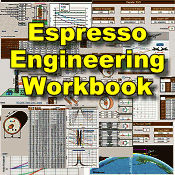 The newest release of RF Cafe's spreadsheet
(Excel) based engineering and science calculator is now available -
Espresso Engineering Workbook™. Among other additions, it now has a Butterworth
Bandpass Calculator, and a Highpass Filter Calculator that does not just gain, but
also phase and group delay! Since 2002,
the original Calculator Workbook has been available as a free download.
Continuing the tradition, RF Cafe Espresso Engineering Workbook™ is
also provided at no cost,
compliments of my generous sponsors. The original calculators are included, but
with a vastly expanded and improved user interface. Error-trapped user input cells
help prevent entry of invalid values. An extensive use of Visual Basic for Applications
(VBA) functions now do most of the heavy lifting with calculations, and facilitates
a wide user-selectable choice of units for voltage, frequency, speed, temperature,
power, wavelength, weight, etc. In fact, a full page of units conversion calculators
is included. A particularly handy feature is the ability to specify the the number
of significant digits to display. Drop-down menus are provided for convenience... The newest release of RF Cafe's spreadsheet
(Excel) based engineering and science calculator is now available -
Espresso Engineering Workbook™. Among other additions, it now has a Butterworth
Bandpass Calculator, and a Highpass Filter Calculator that does not just gain, but
also phase and group delay! Since 2002,
the original Calculator Workbook has been available as a free download.
Continuing the tradition, RF Cafe Espresso Engineering Workbook™ is
also provided at no cost,
compliments of my generous sponsors. The original calculators are included, but
with a vastly expanded and improved user interface. Error-trapped user input cells
help prevent entry of invalid values. An extensive use of Visual Basic for Applications
(VBA) functions now do most of the heavy lifting with calculations, and facilitates
a wide user-selectable choice of units for voltage, frequency, speed, temperature,
power, wavelength, weight, etc. In fact, a full page of units conversion calculators
is included. A particularly handy feature is the ability to specify the the number
of significant digits to display. Drop-down menus are provided for convenience...
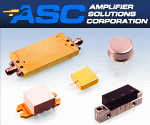 Amplifier Solutions Corporation (ASC) is
a manufacturer of amplifiers for commercial & military markets. ASC designs
and manufactures hybrid, surface mount flange, open carrier and connectorized amplifiers
for low, medium and high power applications using Gallium Nitride (GaN), Gallium
Arsenide (GaAs) and Silicon (Si) transistor technologies. ASC's thick film designs
operate in the frequency range of 300 kHz to 6 GHz. ASC offers thin film
designs that operate up to 20 GHz. ASC is located in an 8,000 sq.ft. facility
in the town of Telford, PA. We offer excellent customer support and take pride in
the ability to quickly react to evolving system design requirements. Amplifier Solutions Corporation (ASC) is
a manufacturer of amplifiers for commercial & military markets. ASC designs
and manufactures hybrid, surface mount flange, open carrier and connectorized amplifiers
for low, medium and high power applications using Gallium Nitride (GaN), Gallium
Arsenide (GaAs) and Silicon (Si) transistor technologies. ASC's thick film designs
operate in the frequency range of 300 kHz to 6 GHz. ASC offers thin film
designs that operate up to 20 GHz. ASC is located in an 8,000 sq.ft. facility
in the town of Telford, PA. We offer excellent customer support and take pride in
the ability to quickly react to evolving system design requirements.
Tuesday the 9th
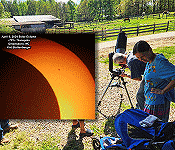 On
April 8, 2024, one of the best total
solar eclipses of the last century crossed the United States from Texas to Maine.
Because the moon was near its closest orbital point to the Earth, and the Earth
was about midway between its orbital apogee and perigee, the sun appeared relatively
small and the moon appeared relatively large. That combination caused the moon's
shadow to be very wide across the face of the Earth. Note in the NASA eclipse map
at the right how much narrower the path of totality was for the August 17, 2017
eclipse. Maximum eclipse for this location was just shy of 81%. That was enough
to cause an eerie feel in the sky, but it was nowhere near dark. Let me state that
when I first became aware of this solar eclipse, it was sometime around 2016, when
I was living in Erie, Pennsylvania. Due to scheduling issues, Melanie and I decided
to not travel to South Carolina to view the August 21, 2017 eclipse, figuring
we would have a front-row seat to it on April 8, 2024, from our house, which
was only a few miles from the center of the path of totality. Life happened, and
we ended up moving back to North Carolina in 2022. Because hotel rooms just about
anywhere in the path of totality were in the $300+ per night range, we stayed here
and missed totality... On
April 8, 2024, one of the best total
solar eclipses of the last century crossed the United States from Texas to Maine.
Because the moon was near its closest orbital point to the Earth, and the Earth
was about midway between its orbital apogee and perigee, the sun appeared relatively
small and the moon appeared relatively large. That combination caused the moon's
shadow to be very wide across the face of the Earth. Note in the NASA eclipse map
at the right how much narrower the path of totality was for the August 17, 2017
eclipse. Maximum eclipse for this location was just shy of 81%. That was enough
to cause an eerie feel in the sky, but it was nowhere near dark. Let me state that
when I first became aware of this solar eclipse, it was sometime around 2016, when
I was living in Erie, Pennsylvania. Due to scheduling issues, Melanie and I decided
to not travel to South Carolina to view the August 21, 2017 eclipse, figuring
we would have a front-row seat to it on April 8, 2024, from our house, which
was only a few miles from the center of the path of totality. Life happened, and
we ended up moving back to North Carolina in 2022. Because hotel rooms just about
anywhere in the path of totality were in the $300+ per night range, we stayed here
and missed totality...
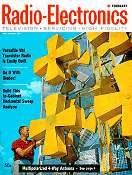 More than half a century has passed
since Radio-Electronics magazine editor Hugo Gernsback wrote this piece
entitled, "Upheaval
in Electronics." In it, he compares the state of the art in electronics since
half a century earlier, which would have been 1911 - a couple years before World
War I began. He stated the obvious, "Just as electronics of today bears no
resemblance to electronics of 50 years ago, the present art cannot be compared to
electronics 50 years hence." Of course he was correct. Present day communications
routinely goes beyond radio frequencies, into microwave, millimeterwave, nanometerwave
(aka light) and onward. As of recent, add to that instantaneous quantum communications
over great distances via "entangled" media. Semiconductor technology was relatively
new in 1961, with the first monolithic integrated circuit having been developed
the year before. As of this writing, Micron has a 5.3 trillion MOSFET memory
chip on the market. An entire FM radio receiver, GPS receiver, and radar receiver
fits on a single die, sans antenna and power supply - Mr. Gernsback's predicted
"diminutive radios." The depth and breadth of modern electronics is impossible to
document in a single printed volume. Even the collective works of Wikipedia does
not comprise a panoptic resource... More than half a century has passed
since Radio-Electronics magazine editor Hugo Gernsback wrote this piece
entitled, "Upheaval
in Electronics." In it, he compares the state of the art in electronics since
half a century earlier, which would have been 1911 - a couple years before World
War I began. He stated the obvious, "Just as electronics of today bears no
resemblance to electronics of 50 years ago, the present art cannot be compared to
electronics 50 years hence." Of course he was correct. Present day communications
routinely goes beyond radio frequencies, into microwave, millimeterwave, nanometerwave
(aka light) and onward. As of recent, add to that instantaneous quantum communications
over great distances via "entangled" media. Semiconductor technology was relatively
new in 1961, with the first monolithic integrated circuit having been developed
the year before. As of this writing, Micron has a 5.3 trillion MOSFET memory
chip on the market. An entire FM radio receiver, GPS receiver, and radar receiver
fits on a single die, sans antenna and power supply - Mr. Gernsback's predicted
"diminutive radios." The depth and breadth of modern electronics is impossible to
document in a single printed volume. Even the collective works of Wikipedia does
not comprise a panoptic resource...
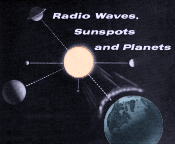 I did a little research on this 1959
Popular Electronics magazine article about John H. Nelson's work on how the
positions of planets affect
magnetic storms on Earth. It looked a little more like astrology than science,
but as it turns out, Nelson's findings gained support in both the astronomical and
meteorological fields. Naturally, the astrology crowd claimed him as part of their
goofiness, but that wasn't Nelson's fault. He published a book in 1974 titled ,"Cosmic
Connections." Yeah, even that sounds like an astrology title - poor choice (or maybe
he was trying to fool the contemporary Pharisees in to buying his book). The book
is out of print now, and I could not find any contemporary work that leverages Nelson's
work. My guess is that due to the relatively short time that observations were made,
the sun had not even gone through a full sunspot cycle. Each sunspot cycle, while
occurring on average every eleven years or so, can vary widely both in intensity
and duration from one period to the next. What might have produced the claimed 85%
accuracy for that particular sunspot cycle likely never provided enough correlation
in subsequent cycles to solidify the theory... I did a little research on this 1959
Popular Electronics magazine article about John H. Nelson's work on how the
positions of planets affect
magnetic storms on Earth. It looked a little more like astrology than science,
but as it turns out, Nelson's findings gained support in both the astronomical and
meteorological fields. Naturally, the astrology crowd claimed him as part of their
goofiness, but that wasn't Nelson's fault. He published a book in 1974 titled ,"Cosmic
Connections." Yeah, even that sounds like an astrology title - poor choice (or maybe
he was trying to fool the contemporary Pharisees in to buying his book). The book
is out of print now, and I could not find any contemporary work that leverages Nelson's
work. My guess is that due to the relatively short time that observations were made,
the sun had not even gone through a full sunspot cycle. Each sunspot cycle, while
occurring on average every eleven years or so, can vary widely both in intensity
and duration from one period to the next. What might have produced the claimed 85%
accuracy for that particular sunspot cycle likely never provided enough correlation
in subsequent cycles to solidify the theory...
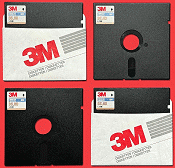 Raise
your hand if you used 5¼" floppy disks (360 kB). Raise your other hand
if you used 3½" floppy disks (720 kB). Take a bow if you used a cassette
tape deck for storing and retrieving programs. I've got both hands raised, and am
bowing over. My first external computer storage consisted of a Sears cassette recorder/player
connected to a Sinclair ZX80 machine
with a membrane keyboard and a 13" color TV for a monitor. That would have been
sometime around 1983. According to Wikipedia, in 1976, Shugart Associates introduced
the 5¼-inch FDD, and IBM the 3½" in 1986. This
IEEE Spectrum article
delves into 3M's (Minnesota Mining and Manufacturing)
role in the removable storage realm.. Raise
your hand if you used 5¼" floppy disks (360 kB). Raise your other hand
if you used 3½" floppy disks (720 kB). Take a bow if you used a cassette
tape deck for storing and retrieving programs. I've got both hands raised, and am
bowing over. My first external computer storage consisted of a Sears cassette recorder/player
connected to a Sinclair ZX80 machine
with a membrane keyboard and a 13" color TV for a monitor. That would have been
sometime around 1983. According to Wikipedia, in 1976, Shugart Associates introduced
the 5¼-inch FDD, and IBM the 3½" in 1986. This
IEEE Spectrum article
delves into 3M's (Minnesota Mining and Manufacturing)
role in the removable storage realm..
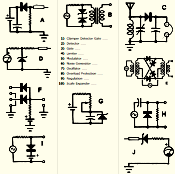 It's time for another pop quiz (does that
line give you a fearsome flashback to your school days?). Whenever I have one available,
I like to post quizzes from vintage electronics magazines, like this one on
diode circuit functions which appeared in the August 1965 issue of Popular
Electronics. Many from that era include vacuum tubes, but this one has the
solid state symbols so the under-40 folks won't be uncomfortable. Your job is to
look at the diode circuits and match them with the names of the functions. A couple
of them will probably cause some head scratching, but you should do well. Don't
jump to a quick conclusion with circuit "E" without noticing the two signal generators
attached to it... It's time for another pop quiz (does that
line give you a fearsome flashback to your school days?). Whenever I have one available,
I like to post quizzes from vintage electronics magazines, like this one on
diode circuit functions which appeared in the August 1965 issue of Popular
Electronics. Many from that era include vacuum tubes, but this one has the
solid state symbols so the under-40 folks won't be uncomfortable. Your job is to
look at the diode circuits and match them with the names of the functions. A couple
of them will probably cause some head scratching, but you should do well. Don't
jump to a quick conclusion with circuit "E" without noticing the two signal generators
attached to it...
 With more than 1000
custom-built symbols, this has got to be the most comprehensive set of
Visio Symbols
available for RF, analog, and digital system and schematic drawings! Every object
has been built to fit proportionally on the provided A-, B- and C-size drawing page
templates (or can use your own). Symbols are provided for equipment racks and test
equipment, system block diagrams, conceptual drawings, and schematics. Unlike previous
versions, these are NOT Stencils, but instead are all contained on tabbed pages
within a single Visio document. That puts everything in front of you in its full
glory. Just copy and paste what you need on your drawing... With more than 1000
custom-built symbols, this has got to be the most comprehensive set of
Visio Symbols
available for RF, analog, and digital system and schematic drawings! Every object
has been built to fit proportionally on the provided A-, B- and C-size drawing page
templates (or can use your own). Symbols are provided for equipment racks and test
equipment, system block diagrams, conceptual drawings, and schematics. Unlike previous
versions, these are NOT Stencils, but instead are all contained on tabbed pages
within a single Visio document. That puts everything in front of you in its full
glory. Just copy and paste what you need on your drawing...
 LadyBug Technologies was founded in 2004
by two microwave engineers with a passion for quality microwave test instrumentation.
Our employees offer many years experience in the design and manufacture of the worlds
best vector network analyzers, spectrum analyzers, power meters and associated components.
The management team has additional experience in optical power testing, military
radar and a variety of programming environments including LabVIEW, VEE and other
languages often used in programmatic systems. Extensive experience in a broad spectrum
of demanding measurement applications. You can be assured that our Power Sensors
are designed, built, tested and calibrated without compromise. LadyBug Technologies was founded in 2004
by two microwave engineers with a passion for quality microwave test instrumentation.
Our employees offer many years experience in the design and manufacture of the worlds
best vector network analyzers, spectrum analyzers, power meters and associated components.
The management team has additional experience in optical power testing, military
radar and a variety of programming environments including LabVIEW, VEE and other
languages often used in programmatic systems. Extensive experience in a broad spectrum
of demanding measurement applications. You can be assured that our Power Sensors
are designed, built, tested and calibrated without compromise.
Monday the 8th
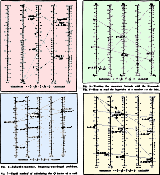 In the March 1967 issue of Radio-Electronics
magazine, John Fasal introduced his "Nomorule"
(a nomograph) as a method of simplifying routine electrical design calculations.
In the days prior to smartphones, desktop computers, and electronic calculators,
the choices for such figuring were paper and pencil, slide rule, or nomograph -
or any combination thereof. The nice thing about a nomograph is the visual presentation
of how varying one or more values affects the result. When the equation at hand
is linear, the mental work of extrapolating numbers is not so hard, but when exponents,
logarithms, or trigonometry functions are involved, things can get tough. Mr. Fasal
instructs you on how to generate a custom nomograph for calculating just about any
equation. The only restriction is that in general only three scales can be in play
at a time - akin to a slide rule - unless other scales happen to fall within the
realm of the primary three. Otherwise, if more than three numbers are involved,
equations must be constructed that combine two or more quantities, with selected
ones fixed at a certain value as a multiplier of the chosen variable. Then, it would
be necessary to construct separate scales for each case. For instance, if you needed
to calculate the voltage across a resistor that was in parallel with a capacitor
and an inductor at various frequencies, you would need to reduce the equation to
just three variables and hold one as fixed. That might be the case for a resonant
circuit across a resistive load, so if the inductor is fixed in value but the capacitor
is adjustable for tuning, an equation would be generated with the L value as a coefficient
and f, C, and R as the nomograph scales. In the March 1967 issue of Radio-Electronics
magazine, John Fasal introduced his "Nomorule"
(a nomograph) as a method of simplifying routine electrical design calculations.
In the days prior to smartphones, desktop computers, and electronic calculators,
the choices for such figuring were paper and pencil, slide rule, or nomograph -
or any combination thereof. The nice thing about a nomograph is the visual presentation
of how varying one or more values affects the result. When the equation at hand
is linear, the mental work of extrapolating numbers is not so hard, but when exponents,
logarithms, or trigonometry functions are involved, things can get tough. Mr. Fasal
instructs you on how to generate a custom nomograph for calculating just about any
equation. The only restriction is that in general only three scales can be in play
at a time - akin to a slide rule - unless other scales happen to fall within the
realm of the primary three. Otherwise, if more than three numbers are involved,
equations must be constructed that combine two or more quantities, with selected
ones fixed at a certain value as a multiplier of the chosen variable. Then, it would
be necessary to construct separate scales for each case. For instance, if you needed
to calculate the voltage across a resistor that was in parallel with a capacitor
and an inductor at various frequencies, you would need to reduce the equation to
just three variables and hold one as fixed. That might be the case for a resonant
circuit across a resistive load, so if the inductor is fixed in value but the capacitor
is adjustable for tuning, an equation would be generated with the L value as a coefficient
and f, C, and R as the nomograph scales.
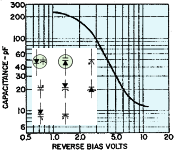 Have you ever used any of these
voltage-variable capacitor (VVC) types: varicaps, epicaps, minicaps, voltacaps,
capistors and varactrons? If you answered "no, but I have used varactor diodes,"
then the more correct answer would have "yes, I have, but by a different name."
Construction was similar for all variations. This article from a 1969 issue of
Radio-Electronics magazine reports on some of the earliest forms of diodes
specifically designed to use a reverse bias on the PN junction to control the effective
capacitance of the device for use in frequency tuning circuits. The first uses were
for electronically tuning local oscillators in mixing stages, and then for making
tunable filters. Capacitance ratios greater than 10:1 with some VVCs allowed tuning
over a very wide range. At the time the article was written, there was not universally
agreed upon schematic symbol for the VVC, as illustrated in Figure 2. Varactor-tuned
television channel selectors made for much smaller tuner assemblies with fewer adjustments
for alignment across the entire VHF and UHF bands... Have you ever used any of these
voltage-variable capacitor (VVC) types: varicaps, epicaps, minicaps, voltacaps,
capistors and varactrons? If you answered "no, but I have used varactor diodes,"
then the more correct answer would have "yes, I have, but by a different name."
Construction was similar for all variations. This article from a 1969 issue of
Radio-Electronics magazine reports on some of the earliest forms of diodes
specifically designed to use a reverse bias on the PN junction to control the effective
capacitance of the device for use in frequency tuning circuits. The first uses were
for electronically tuning local oscillators in mixing stages, and then for making
tunable filters. Capacitance ratios greater than 10:1 with some VVCs allowed tuning
over a very wide range. At the time the article was written, there was not universally
agreed upon schematic symbol for the VVC, as illustrated in Figure 2. Varactor-tuned
television channel selectors made for much smaller tuner assemblies with fewer adjustments
for alignment across the entire VHF and UHF bands...
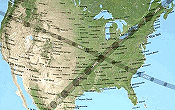 "When a rare
total solar eclipse sweeps across North America on April 8, scientists will
be able to gather invaluable data on everything from the Sun's atmosphere to strange
animal behaviors - and even possible effects on humans. It comes with the Sun near
the peak of its 11-year solar cycle, setting the stage for a breathtaking display:
The corona will glow spectacularly from the Moon's silhouette along the path of
totality, a corridor stretching from Mexico to Canada via the United States. Total
solar eclipses offer 'incredible scientific opportunities,' NASA Deputy Administrator
Pam Melroy told a press conference this week about the celestial event. The U.S.
space agency is one of the institutions at the ready for the eclipse, with plans
to launch so-called 'sounding rockets' to study the effects on Earth's upper atmosphere..." "When a rare
total solar eclipse sweeps across North America on April 8, scientists will
be able to gather invaluable data on everything from the Sun's atmosphere to strange
animal behaviors - and even possible effects on humans. It comes with the Sun near
the peak of its 11-year solar cycle, setting the stage for a breathtaking display:
The corona will glow spectacularly from the Moon's silhouette along the path of
totality, a corridor stretching from Mexico to Canada via the United States. Total
solar eclipses offer 'incredible scientific opportunities,' NASA Deputy Administrator
Pam Melroy told a press conference this week about the celestial event. The U.S.
space agency is one of the institutions at the ready for the eclipse, with plans
to launch so-called 'sounding rockets' to study the effects on Earth's upper atmosphere..."
National Solar Observatory
Eclipse Map - Data for your location. My area gets a lousy 81%, which won't
even cause a noticeable darkening. At 66 years old, this was my last chance to see
a total eclipse.
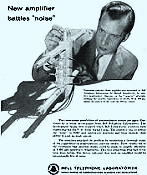 Rudolf Engelbrecht, an alum of Oregon state
University, was inducted into the institution's Engineering Hall of Fame in 1998.
As evidenced in this full-page advertisement in a 1958 issue of Radio &
TV News magazine, Mr. Engelbrecht's work was instrumental in advancing
the state of the art in communications electronics while an engineer at Bell Telephone
Laboratories (aka Bell Labs). Here, he is show with the four-stage junction diode
amplifier developed for military applications. It exploited the variable capacitance
nature of a varactor type diode to effect amplification in the UHF and microwave
bands. Engelbrecht went on to work at Radio Corporation of America (RCA) later in
his career. BTW, if you are wondering what other kind of diode might there be other
than a "junction" diode, the answer is that the earliest semiconductor diodes were
"point contact" types which used a sharpened metal wire to make contact with the
semiconductor substrate. Of course before that were vacuum tube diodes, but they're
not semiconductor-based... Rudolf Engelbrecht, an alum of Oregon state
University, was inducted into the institution's Engineering Hall of Fame in 1998.
As evidenced in this full-page advertisement in a 1958 issue of Radio &
TV News magazine, Mr. Engelbrecht's work was instrumental in advancing
the state of the art in communications electronics while an engineer at Bell Telephone
Laboratories (aka Bell Labs). Here, he is show with the four-stage junction diode
amplifier developed for military applications. It exploited the variable capacitance
nature of a varactor type diode to effect amplification in the UHF and microwave
bands. Engelbrecht went on to work at Radio Corporation of America (RCA) later in
his career. BTW, if you are wondering what other kind of diode might there be other
than a "junction" diode, the answer is that the earliest semiconductor diodes were
"point contact" types which used a sharpened metal wire to make contact with the
semiconductor substrate. Of course before that were vacuum tube diodes, but they're
not semiconductor-based...
 Banner Ads are rotated in all locations
on the page! RF Cafe typically receives 8,000-15,000 visits each
weekday. RF Cafe
is a favorite of engineers, technicians, hobbyists, and students all over the world.
With more than 17,000 pages in the Google search index, RF Cafe returns in
favorable positions on many types of key searches, both for text and images.
Your Banner Ads are displayed on average 280,000 times per year! New content
is added on a daily basis, which keeps the major search engines interested enough
to spider it multiple times each day. Items added on the homepage often can be found
in a Google search within a few hours of being posted. If you need your company
news to be seen, RF Cafe is the place to be... Banner Ads are rotated in all locations
on the page! RF Cafe typically receives 8,000-15,000 visits each
weekday. RF Cafe
is a favorite of engineers, technicians, hobbyists, and students all over the world.
With more than 17,000 pages in the Google search index, RF Cafe returns in
favorable positions on many types of key searches, both for text and images.
Your Banner Ads are displayed on average 280,000 times per year! New content
is added on a daily basis, which keeps the major search engines interested enough
to spider it multiple times each day. Items added on the homepage often can be found
in a Google search within a few hours of being posted. If you need your company
news to be seen, RF Cafe is the place to be...
These archive pages are provided in order to make it easier for you to find items
that you remember seeing on the RF Cafe homepage. Of course probably the easiest
way to find anything on the website is to use the "Search
RF Cafe" box at the top of every page.
About RF Cafe.
Homepage Archive Pages
2024:
Jan |
Feb |
Mar |
Apr |
May |
Jun |
Jul |
Aug |
Sep |
Oct |
Nov |
Dec
2023:
Jan |
Feb |
Mar |
Apr |
May |
Jun |
Jul |
Aug |
Sep |
Oct |
Nov |
Dec
2022:
Jan |
Feb |
Mar |
Apr |
May |
Jun |
Jul |
Aug |
Sep |
Oct |
Nov |
Dec
2021:
Jan |
Feb |
Mar |
Apr |
May |
Jun |
Jul |
Aug |
Sep |
Oct |
Nov |
Dec
2020:
Jan |
Feb |
Mar |
Apr |
May |
Jun |
Jul |
Aug |
Sep |
Oct |
Nov |
Dec
2019:
Jan |
Feb |
Mar |
Apr |
May |
Jun |
Jul |
Aug |
Sep |
Oct |
Nov |
Dec
2018:
Jan |
Feb |
Mar |
Apr |
May |
Jun |
Jul |
Aug |
Sep |
Oct |
Nov |
Dec
2017:
Jan | Feb |
Mar |
Apr |
May |
Jun |
Jul |
Aug |
Sep |
Oct |
Nov |
Dec
2016:
Jan |
Feb |
Mar |
Apr |
May |
Jun |
Jul |
Aug |
Sep |
Oct |
Nov |
Dec
2015:
Jan |
Feb |
Mar |
Apr |
May |
Jun |
Jul |
Aug |
Sep |
Oct |
Nov |
Dec
2014:
Jan |
Feb |
Mar |
Apr |
May |
Jun |
Jul |
Aug |
Sep |
Oct |
Nov |
Dec
2013:
Jan |
Feb |
Mar |
Apr |
May |
Jun |
Jul |
Aug |
Sep |
Oct |
Nov |
Dec
2012:
1 |
2 |
3 |
4 |
5 |
6 |
7 |
8 |
9 |
10 |
11 |
12 |
13 (no archives before 2012)
|

























 LadyBug Technologies
LadyBug Technologies


 Rudolf Engelbrecht
Rudolf Engelbrecht